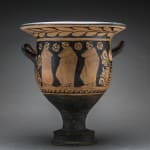Campanian Red and White-Figure Bell Krater, 400 BCE - 300 BCE
Terracotta
height 42.9 cm
height 16 7/8 in
height 16 7/8 in
AM.0034
Further images
Campania was the first place to be settled by the Greeks in Italy, around 650 BC; by 350 BC the region was producing superb pottery thanks to immigrant Sicilian potters...
Campania was the first place to be settled by the Greeks in Italy, around 650 BC; by 350 BC the region was producing superb pottery thanks to immigrant Sicilian potters and painters. Before the modern advents of trains and automobiles, trade between civilizations concentrated around the Mediterranean moved foremost by sea. While many bulk commodities such as timber and stone could be loaded directly aboard a ship with little preparation, other commodities such as spices, wine, and grain needed to be packed in individual containers for transport both at sea and on land and to prolong their lifespan. Pottery was first created in order to fulfil these practical needs. Over time, the art form evolved from large, unadorned commercial transport vessels to refined, specialized works in elegant shapes used to hold precious substances such as perfume or oils. An entire retinue of terracotta vessels dedicated to the rites of the dinner table began to appear. These pieces were based on the luxurious bronze and silver vessels that could only be afforded by the wealthy elite and were decorated with fanciful natural motifs and painted scenes of everyday life and celebrated myths. These wares were of such beauty that they themselves became prized commodities and were traded throughout the Mediterranean world; perhaps even for the very substances, they were created to contain. These works are individually classified by their shapes and their form was inherently linked to their function, be it preparation, dispensation, or consumption. One of these specific types, kraters are large bowl-shaped vessels with wide mouths and two handles that stand on footed bases. Foremost among the different types of kraters is the bell krater, so-called because it emits a pleasant ringing sound, not unlike a bell when gently struck with a finger. Kraters were an integral piece of equipment used during the symposium, an ancient Greek dinner and drinking banquet immortalized by Plato. Symposia were hosted inside the private residences of the upper classes, held inside a special room complete with a floor that sloped into a central drain to facilitate cleaning the morning after. Music played by hired consorts and highbrow political and philosophical discussions were the main activities; although, as the evening transpired and the effects of the wine took over, more physical pleasure became the true focus. Wine would be diluted with water inside the krater before the mixed concoction would be dispensed to the individual revellers. Kraters were often decorated with painted scenes depicting groups of figures dining and relaxing, activities that paralleled the festivities of the symposia during which the vessels were actually used. At first, vase painters emulated the black-figure style employed by the Corinthians. In the black-figure technique, the vase surface was covered with a diluted wash of clay. A thicker solution of iron-rich clay formed the "glaze" used to paint on figures in solid silhouette. Intricate details were then incised onto the figures. Finally, painted red and white highlights were added before firing. However, by 480 B.C., the black- figure style would be effectively replaced by red- figure wares which first appeared around 530. In the red-figure technique, the process was reversed and the figures appeared in red against a black background. The liquid glaze was used to outline the figures. Contours and inner lines were then added. The painted lines could be diluted to a golden brown or left jet black. After the figures were drawn, the background was added in black and the pot fired. Although the red-figure technique lacks the sharpness of black-figure painting, the increased painterly effects, the greater sense of movement, and the heightened emotions more than make up the difference.









